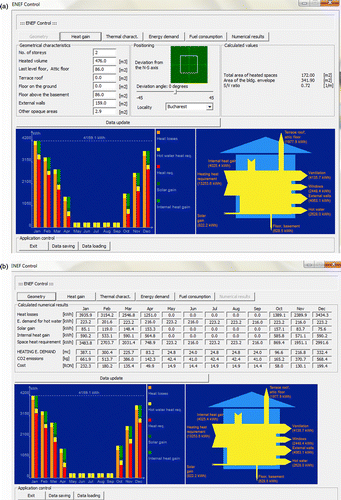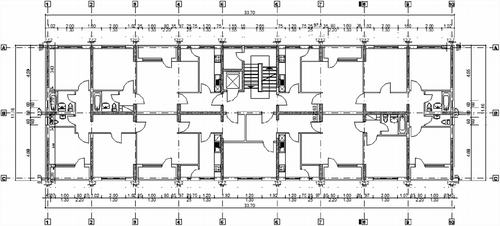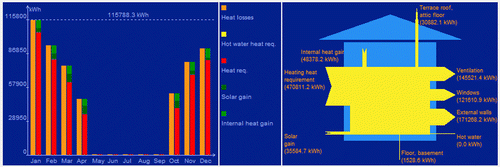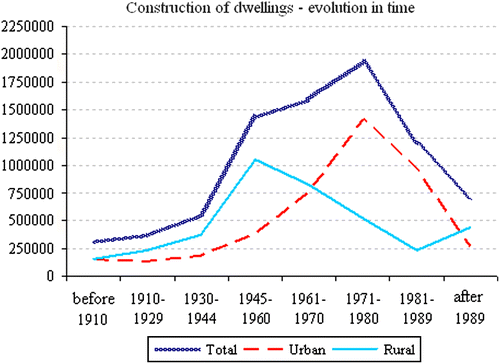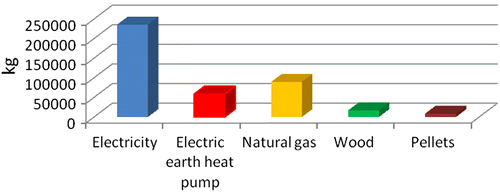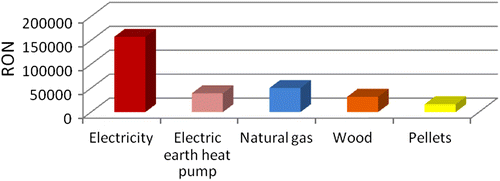Abstract
The numerous buildings that currently require thermal rehabilitation in Romania means that substantial resources and a large number of competent people are required to carry out surveys and energy audits. However, commercial energy balance software is mostly unaffordable for those organisations involved in this process. This paper describes an energy balance programme – ENEFControl – developed to be a rapid, low cost, local tool able to assist in the choice of energy efficient solutions for buildings. To test the software, thermal and energy analyses were carried out on a 1970s built apartment block in Transylvania. Based on these analyses, three constructive scenarios were proposed for thermal rehabilitation. Compared to the performance of the analysed building, the thermal and energy performance of the retrofitted building in all three scenarios significantly improved. Since European Union accession in 2007, rapidly rising energy costs have affected the Romanian population. ENEFControl offers Romanian engineers and architects an opportunity to speed up the rehabilitation programme of buildings without the need for more expensive expertise and tools.
1. Introduction
In Romania, the residential sector is the second largest energy consumer after industrial consumption, with 32.1% of Romania's total energy consumption. Romania has almost double the energy consumption for heating and hot water compared to other European Union countries (Cerna-Mladin et al. Citation2003); therefore, the potential for energy efficient retrofitting of buildings is very high. Due to a continuous improvement in living standards, the annual consumption of raw energy and CO2 emissions per capita are estimated to be growing at an alarming rate, clearly suggesting that the implementation of energy efficiency measures in the Romanian residential sector is essential for designers.
The large number of buildings designed and erected in Romania between 1960 and 1996 is defined by inappropriate levels of thermal insulation and low efficiency of heat distribution systems. This has resulted in high levels of energy consumption and unsuitable levels of user comfort. In the 1980s, a number of measures for reducing energy consumption (Cocora and Berbecaru Citation2004, Comsa Citation2004) in the residential sector were identified as:
| • | the lowering of in-house temperature from 20 to 18°C (Standard 6472/3-84); | ||||
| • | the reduction in the amount of fuel necessary for heating and domestic hot water; | ||||
| • | the constraint of having values of heat protection less than that which provides thermal comfort (Table ); this decision had long-term negative consequences for the population.
Table 1 Values of required heat transfer coefficient between 1961 and 2006. | ||||
A substantial improvement in thermal insulation was imposed by the adoption of Methodology Mc 001/1-2006. This included the provisions of EU Directive 91/2002 aimed at improving domestic in-house comfort and reducing the energy required for space heating in dwellings. In Romania, concerns regarding improving building energy performance are mostly focused on legislation and less on rehabilitation works, as the effects of the economic crisis make it impossible to continue to apply financial policies supporting thermal rehabilitation of the existing building stock (Cobirzan et al. Citation2010, Moga and Moga Citation2010, Tudor et al. Citation2010).
In 2010, the monthly expenses for heating and domestic hot water preparation represented approximately 40% of the average gross national income of 800 RON (source: National Statistics Institute); the equivalent of EUR 190 in Romanian currency.Footnote3 At the same time, the population was increasingly less able to pay the maintenance, heating and environment protection costs of dwellings. Measures that make buildings more thermally efficient have become an imperative; the reduction in energy costs is now one of the most important issues for home owners. However, depending on the solution adopted, the cost of thermal retrofitting is high and the payback time is relatively long.
Privately owned homes represent 97% of the overall dwelling stock in Romania (Institutul National de Statistica Citation2002). Many owners are pensioners or employees who are paid the minimum salary and cannot afford to invest in thermal rehabilitation. These works cannot be carried out with state subsidies for a single flat, but subsidies for an entire block of flats or for a section are available. Consequently, some of the owners resort to individually rehabilitating their own flats, but without first analysing the difference between actual energy efficiency and the specified one. Such rehabilitation is not only inefficient in most cases, but also contributes to damaging the appearance of the building's façade (Figure (a,b)).
Figure 1 (a) Individual thermal rehabilitation of apartments. (b) Individual thermal rehabilitation of apartments (detail).
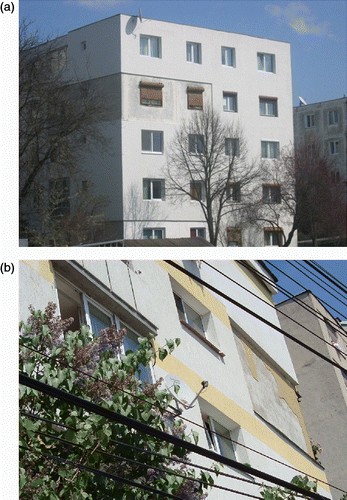
A simplified calculation of the energy balance can show heat loss distribution and therefore, guide the user towards measures to improve thermal insulation, in order to maximise energy saving. Commercial energy balance software – such as LESOSAI, EPIQR and CASAnova – is mostly unaffordable (price and difficulty of use) for design companies in Romania. There are also four programmes agreed on the national plan (CitationALLPLAN, CitationALLENERGY, CitationDOSET and CitationCertificat-Energetic), which are dedicated to energy auditing and the issuing of performance certificates for buildings. These too are expensive and require high expertise for use, and do not respond adequately to the needs to which the ENEFControl programme responds. The ENEFControl software was designed by the authors as a more accessible, local tool. It is both quick and easy to use in the building design stage or for evaluating existing energy performance.
2. Description of the software
The ENEFControl software is designed to calculate the amount of energy required for heating and domestic hot water and the resulting CO2 emissions according to standard Mc 001/1-2006. It is based on the methods of calculus applied to a stationary regime according to the Romanian norms in force (C 107/1-2005 and Mc 001/1-2006). These norms take into consideration factors including outside temperature (number of degrees/days by location, the effect of internal heat gain caused by domestic electrical appliances, home automation and the contribution of solar gain).
The software input data are: the geometry and physical parameters of the building (including average internal temperature, ventilation rate, features of the building envelope) and fuel type (Figure (a,b)). The software includes databases of window and fuel types, which can be modified or updated later. It enables the insertion into the calculations of the effects of using renewable sources of energy. In this way, the user can make decisions both during the design stage and when retrofitting a building, while taking into account climate, the orientation of the building and the building envelope.
Results are displayed graphically and in the form of tables and histograms (Figure (a,b)). The software can show the user the heat (energy consumed for heating with respect to the efficiency of the heating system) and energy (total energy required for space heating and domestic hot water) required considering the efficiency of the heating system, plus heat losses through the building envelope, the effect of internal and solar heat gains detailed for each month, the estimation of the energy costs related to the type of fuel used and CO2 emissions.
The six windows of the software: geometry, heat gain, thermal characteristics, energy demand, fuel consumption and numerical results are interdependent and operate as follows:
| 1. | After introducing the geometric characteristics of the building envelope, the programme calculates the heated area, the overall building envelope area and the A/V ratio (area/volume); very important in the design stage. | ||||
| 2. | With the values of glazed elements corrected from thermal resistance and the coefficient of solar gains selected from the programme databases, the solar gain Q s for the heating period is calculated, also taking into account the building orientation. By selecting the shading coefficient the user can get more reliable results. | ||||
| 3. | The values of the corrected thermal resistance (R′ = 1/U′) of the opaque elements of the building envelope are introduced, and the average thermal resistance of the whole building envelope ( | ||||
| 4. | By processing the above data, the energy required for heating (Q h) and for hot water preparation (Q hw) is calculated. | ||||
| 5. | The programme enables the user to calculate the necessary area of solar collector panels for ensuring the energy for hot water delivery, based on the values of solar radiation available in the databases. The energy consumption for space heating and hot water, as well as the CO2 emissions result depending on the necessary heat, the energy source (fossil or/and renewable) and the performance of the heating system. | ||||
| 6. | The final results are displayed in the last window. | ||||
The ENEFControl software is a useful instrument for designers and other professionals. It can be used in the design stage to make an accurate and effective analysis of the energy efficiency of a specific building. The main advantages of the ENEFControl software are as follows:
| 1. | Overcoming the drawbacks inherent in the design stage due to deficiencies in the norms in force, such as the thermal resistance minimum value (R min) of the envelope not being specified individually for all climatic zones.Footnote4 Not considering such local parameters can lead to energy inefficiency. | ||||
| 2. | By selecting the most suitable shading coefficient, the user can determine the actual energy required if the building has shade systems installed, or is shaded by the buildings in the vicinity; an aspect that is often neglected. | ||||
| 3. | The software provides the opportunity to select the most advantageous solution for a minimum energy consumption, while considering external temperature variations (number of degrees/days per location), and the effect of internal and solar heat gains. | ||||
η = utilisation reduction factor taking into account the dynamic effect of internal and solar heat gains due to the variation in internal and external temperatures; | |||||
Q L = heat losses through the building envelope (exterior walls, glazing and floors), [J] and | |||||
Q g = total heat gains (internal and solar radiation) [J]. | |||||
3. Case study
The following section presents results obtained based on the thermal and energy analysis of a block of flats with a basement, ground floor and 10 upper floors (Figure ) made through both analytical (regular calculation and reference building) and numerical methods using the ENEFControl software (analysed building).
3.1 Thermal analysis of the building
The building is a block of flats, constructed in 1976, located in the city of Satu-Mare (North-Western region of Transylvania). The façades and other details are shown in Figure (a–c). The geometric data and thermal characteristics of the component parts of the building envelope (Table ) were calculated following the provisions of the Calculation Methodology Mc 001/1-2006.
Figure 4 (a) Analysed building (façade). (b) Analysed building (end view). (c) Analysed building (roof detail).
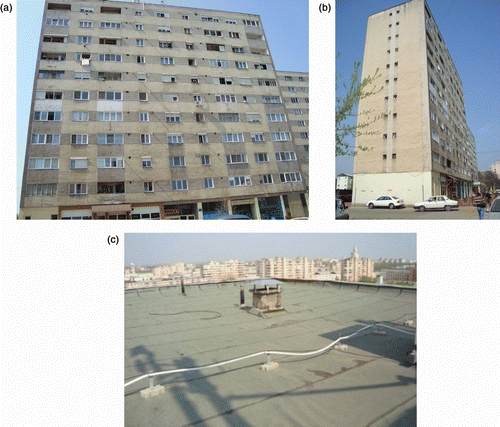
Table 2 Geometric and thermal characteristics of the case study building.
The load-bearing structure is constructed of 20-cm thick cast in situ orthogonally disposed reinforced concrete transversal shear walls. The external 25-cm thick infill walls of the longitudinal façades are of lightweight aerated concrete blocks, while the 12.5-cm thick end shear walls of the transversal façades are clad with vertical lightweight aerated reinforced concrete strips.
Floors are constructed of reinforced concrete slabs, 13-cm thick. The concrete class is C16/20 (B250 – according to the norms in force at the time of the design). The basement, developed under the entire building area, was flooded by infiltrations caused by leaking waste water pipes. Moisture is visible on the basement wall surfaces both internally and externally.
The data of a comparative study obtained by analysing the real building (the construction as built) and the reference building (a virtual building, geometrically identical to the real one, accomplishing the minimal requirements for thermal comfort required by regulations in force) are presented in Table , which clearly demonstrates the accuracy of the programme results.
Table 3 Thermal characteristics of the case study building envelope.
The results displayed in Table show that:
| • | the effective global thermal insulation coefficient (G ef) of the analysed building shows the low energy performance;1.43-fold lower than the reference building (G ref); | ||||
| • | consequently, the specific annual heat consumption of the analysed building (Q N) is 1.53-fold higher than that of the reference building (Q Nref); | ||||
| • | at the heating source level, the specific annual heat consumption of the analysed building is 1.76-fold higher than that of the reference building. | ||||
| • | Specific heat losses through direct transmission represent 69% with 31% of the total loss caused by ventilation (Figure ).
| ||||
3.2 Energy audit – constructive measures for improving energy performance
Based on the analysis of the thermal and energy performance of the building envelope, three constructive scenarios are proposed for thermal rehabilitation (Table ). Based on the proposed scenarios, significant energy savings can be obtained as shown by the results of the energy analysis presented in Table . Although the relative difference between scenarios is not large, each of them represents a significant improvement in the energy performance compared to the original building.
Table 4 Constructive scenarios proposed for thermal rehabilitation.
Table 5 Thermal characteristics of the building envelope after thermal rehabilitation.
Following energy performance analysis, the synthesis of the results for the building in all three thermal rehabilitation scenarios is shown in Table . Compared to the performance of the analysed building, the thermal and energy performance of the retrofitted building in all three scenarios has significantly improved. The CO2 emissions and costs of energy for heating after thermal rehabilitation, depending on the type of fuel used (first solution), are shown in Figures and .
Table 6 Energy performance values of the building after thermal rehabilitation.
4. Conclusion
Over 97% of the residential buildings in Romania were built before 1993. They are characterised by poor thermal insulation and therefore, have a high level of energy consumption for space heating and domestic hot water. Because of this, the need for thermal rehabilitation in order to make them more energy-efficient has become imperative. Unfortunately, Romania has not yet achieved this desired result. The factors that have led to this situation are economic and social in nature; i.e. relatively low energy costs coupled with a lack of public awareness of the necessity of saving energy and reducing CO2 emissions. With the accession of Romania to the EU in 2007, subsidies granted by the state for fuels were eliminated and the population is becoming increasingly concerned with rapidly rising energy costs.
To survey and energy audit the large number of buildings requiring thermal rehabilitation would require a large number of professionals with this expertise and would take a long time to complete. This is the reason why the ENEFControl programme was created; to act as a useful and easy to use tool in the expert appraisal/survey stage, allowing the user to survey buildings quickly. By using the ENEFControl programme, the user can identify how much supplementary thermal insulation is needed and where this should be placed, thus speeding the rehabilitation programme of these buildings without the need for more expensive expertise. The above considerations also demonstrate the explicit need for the optimisation of new buildings (in terms of energy efficiency and emissions reduction) using the ENEFControl energy balance sheet for evaluating the energy performance in several variants in the early stage of design.
The energy efficiency of buildings in the context of sustainable development requires a multidisciplinary approach to the design or rehabilitation of buildings through close collaboration between specialists including architects, civil and building services engineers and economists, who also need to have an adequate knowledge in complementary fields of expertise. Without this multidisciplinary approach the creation of this programme would not have been possible.
Additional information
Notes on contributors
N. Cobîrzan
1M. Brumaru
2Notes
3. Mc 001-2006 is the Romanian methodology for the calculation of buildings' energy performance, a holistic approach addressed to heat, ventilation and air conditioning (HVAC) and hot water preparation, based on European standards (SR EN). Result of own calculation using the local data, based on already performed building energy auditing.
4. In Romania, there are four climatic zones.
1. Email: [email protected]
2. Email: [email protected]
References
- ALLENERGY, S.C., IPCT INSTALATII, S.R.L., Available from: http://www.algorithm.ro/produce-software-utilitar-allenergy-software-v40-cladiri.html
- ALLPLAN, Nemetschek Romania sales & support S.R.L. Available from: http://www.nemetschek.ro
- Calculul termotehnic al elementelor de inchidere ale cladirilor [Thermal calculation of building envelope elements], 1984. Standard 6472/3-84
- Cerna-Mladin, E., Georgescu, M., and Dutianu, D., 2003. Energy efficiency in buildings – the Romanian condition and the community aquis. Round table organised by ENERO, OPET Building Project, 28 August, 2003. Available from: http://www.enero.ro/en/projects/opetbuilding/index.pdf
- Certificat-Energetic [Energy Performance Certificate], S.C. ATH energ S.R.L [Energy]. Available from: http://www.certificat-energetic.com
- Cobirzan , N. , Popa , A. , Aciu , C. and Brumaru , M. 2010 . Implementing the concept of sustainable development in thermal rehabilitation of residential buildings in Romania , 37th IAHS World Congress on Housing “Design, Technology, Refurbishment and Management of Buildings”, 26–29 October 2010, Santander, Spain
- Cocora, O., and Berbecaru, D., 2004. Utilizarea eficientă a energiei în clădiri: manual pentru personalul din serviciile tehnice ale autorităţilor locale [Efficient use of energy in buildings: handbook for technical services personnel in local administration], Ed. Alma Mater, Sibiu
- Comsa, E., 2004. Gradul de protectie termica al cladirilor din Romania, Cadrul organizatoric, probleme si metode de solutionare pentru aplicatii energetice eficiente in diferite tipuri de cladiri din Romania. Lucrarile simpozionului din 27–28 ianuarie, 2004, Editura Universitatii Translivania Brasov [Degree of thermal protection of buildings in Romania: Organisational framework and problems and solutions for efficient energy usage in different types of buildings in Romania. Transylvania University, Brasov, Proceedings of the 2004 Symposium, 27–28 January]
- Council Directive, 2002/91/EC of 16 December 2002 on the energy performance of buildings
- DOSET. S.C. DOSET Impex S.R.L. Available from: http://www.dosetimpex.ro/doset-pec/info.php
- Fizica constructiilor [Building Physics], Termotehnica [Thermal Engineering]. Calculul rezistentei la transfer termic si la stabilitate termica [Heat transfer and thermal stability calculation], 1975. Standard 6472/3-75
- Institutul National de Statistica [National Institute of Statistics], 2002. The 2002 census on population and dwellings in Romania, Available from: http://www.insse.ro/cms/files/RPL2002INS/vol3/grafice/g3.htm [Accessed December 2010]
- Metodologie de calcul al performanţei energetice a clădirilor Partea I – Anvelopa clădirii [Methodology for the calculation of building energy performance, Part I – The Building Envelope], 2006. Mc 001/1-2006
- Moga , L. and Moga , I. 2010 . Aspects regarding the thermal performance of the building envelope elements having glazing surfaces [Aspects regarding the thermal performance of the building glazed surfaces envelope elements] , Analele Universitaˇţii din Oradea [Annals of the University of Oradea] . Vol. XIII, Fascicula Construcţii Şi Instalaţii Hidroedilitare, Vol. XIII-2 [Volume XIII – Construction and Building Services], 2010, Oradea, Romania, ISSN 1454-4067
- Normativ privind calculul coeficienţilor globali de izolare termică la clădirile de locuit [Norms for the calculation of global thermal insulation coefficients for residential buildings], 2005. C107/1-2005
- Normativ privind calculul termotehnic al elementelor de construcţie ale clădirilor [Norms for the calculation of the thermal performances of buildings' elements], 1997. C107/1-97
- Norme privind masuri pentru reducerea consumurilor de material si manopera, a consumurilor de energie si combustibil in proiectarea, executia si exploatarea constructiilor de locuinte [Norms concerning measures for the reduction of materials, manual labour, energy and fuel consumption in the design, construction and usage of residential buildings], 1987. NP 15-87
- Termotehnica in constructii, Elemente fundamentale de calcul [Thermal Engineering in Constructions, Fundamentals of Calculation], 1961. Standard 6472/3-1961
- Tudor , D.F. , Prada , M.F. and Fumo , M. 2010 . Thermal rehabilitation of the condominium by creating apartments in the attic , Analele Universitatii din Oradea . Vol. XIII, Fascicula Construcţii Şi Instalaţii Hidroedilitare, Vol. XIII-2 [Thermal rehabilitation of the condominiums by creating apartments in the attic. Annals of the University of Oradea. Volume XIII – Constructions and Building Services], 2010, Oradea, Romania, ISSN 1454-4067
